Introduction
In the ever-evolving landscape of software development, maintaining code quality and efficiency is paramount. Cyclomatic complexity, a critical metric for evaluating the intricacies of a program’s control flow, emerges as an essential tool for developers aiming to produce robust, maintainable software. By calculating the number of linearly independent paths through a program's source code, this metric sheds light on potential problem areas that may hinder understanding, maintenance, or testing.
Tools like Phanalist and Dep Tree have revolutionized the way developers visualize and manage cyclomatic complexity, enabling them to keep their code within manageable thresholds. This article delves into the significance of cyclomatic complexity, its historical development, calculation methods, and its pivotal role in software engineering and testing. Additionally, it explores practical strategies for reducing complexity and highlights the tools available for its measurement, ensuring that software teams can consistently deliver high-quality, reliable code.
What is Cyclomatic Complexity?
Cyclomatic complexity is a crucial software metric for evaluating the intricacy of a program's control flow. It calculates the number of linearly independent paths through a program's source material, offering valuable insights into the potential difficulties in understanding, maintaining, or testing different sections of the content. This metric is especially significant for developers concentrated on software quality and efficiency, as it emphasizes complex areas that may need refactoring. Tools such as Panelist can automatically compute code intricacy, assisting developers in recognizing and tackling high-intricacy methods before they turn into issues. By keeping control flow metrics below a certain limit, usually around 10, developers can ensure their code remains manageable and easier to maintain.
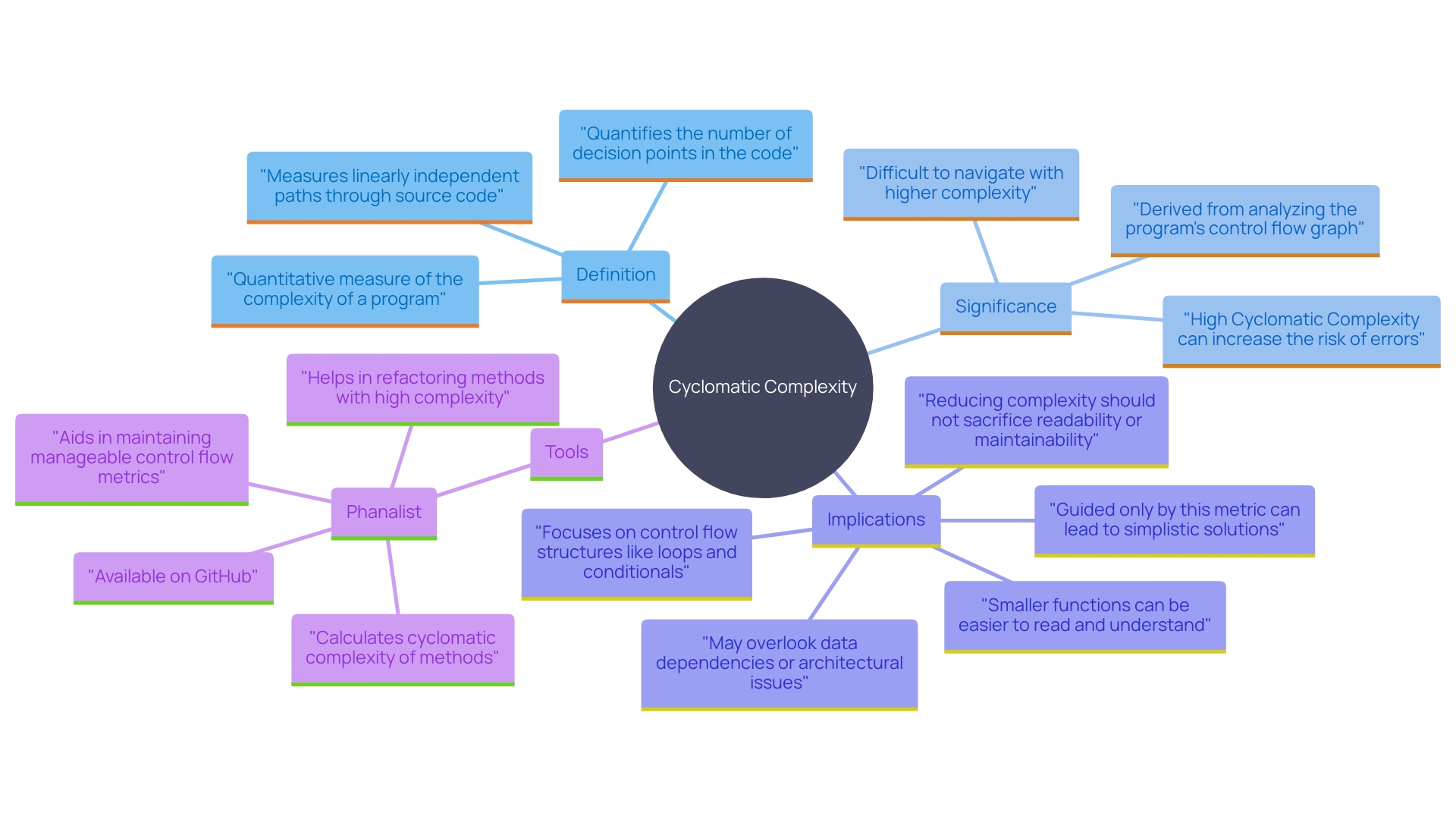
History and Development of Cyclomatic Complexity
Thomas J. McCabe presented the idea of cyclomatic intricacy in 1976 as part of his study on program testing and reliability. This metric was created to offer a numerical assessment of system intricacy, thereby improving testing approaches. Cyclomatic intricacy has since become incorporated into various software development methods and is acknowledged as a standard measure for assessing program quality.
Contemporary instruments such as Phanalist and Dep Tree have further enhanced our capacity to visualize and compute code intricacy. Dep Tree, for instance, utilizes a 3D force-directed graph to illustrate the connections among source files, offering a clear depiction of programming intricacy. Phanalist, in contrast, computes the structural intricacy of methods, urging developers to rework methods that surpass a level of 10, thereby making the program simpler to comprehend and manage.
The significance of such metrics is highlighted by the substantial expenses linked to faulty programs. In 2022, the costs in the United States alone surpassed $2 trillion, according to the Consortium for Information & Software Quality (CISQ). Tools for understanding, finding, and fixing deficiencies are crucial in addressing these issues. As applications expand and develop, preserving code quality through measurements like cyclomatic complexity becomes crucial for both ongoing and upcoming development.
The effect of these tools and practices is clear in the focus on enhancing development productivity and quality. Researchers and practitioners alike can build on these methodologies to enhance the overall tradeoffs in software development, leading to better, more reliable software systems.
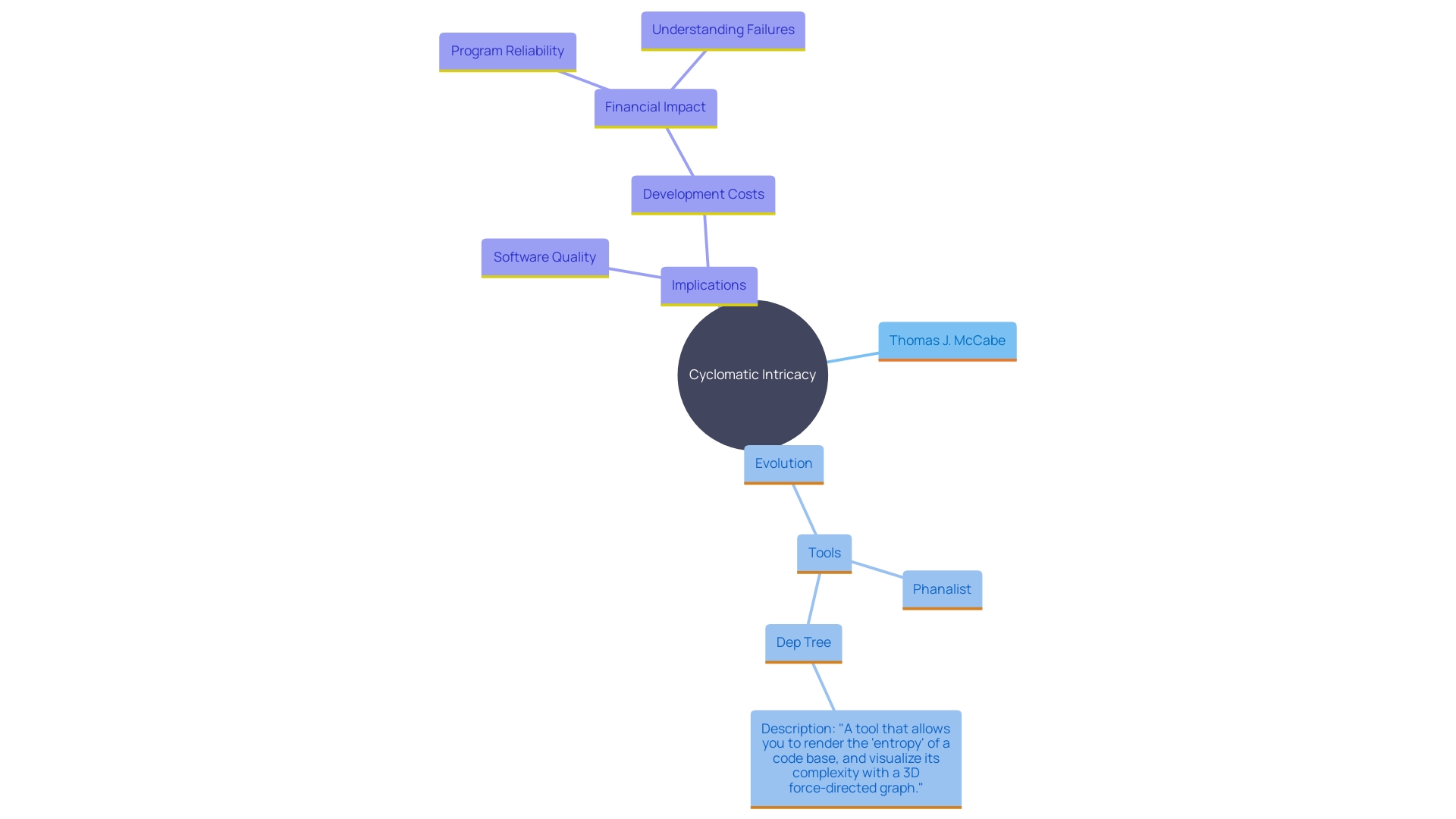
Calculating Cyclomatic Complexity
Cyclomatic measurement is a crucial metric for understanding the intricacies of a program's control flow. It is calculated using a control flow graph (CFG), which maps out the various paths a program can take during execution. The formula for determining cyclomatic complexity (M) is:
M = E - N + 2P
Where:
- E represents the number of edges in the graph,
- N is the number of nodes in the graph,
- P denotes the number of connected components, typically 1 for a single program.
This formula offers a numerical value indicating the intricacy of the program's structure. Tools such as Dep Tree can display this intricacy using a 3D force-directed graph, where nodes (indicating source files) and edges (indicating imports) demonstrate the interconnectedness and detail of the codebase. By using such techniques, developers can achieve a clearer comprehension of their program's intricacy, making it easier to pinpoint areas that may require simplification or restructuring.
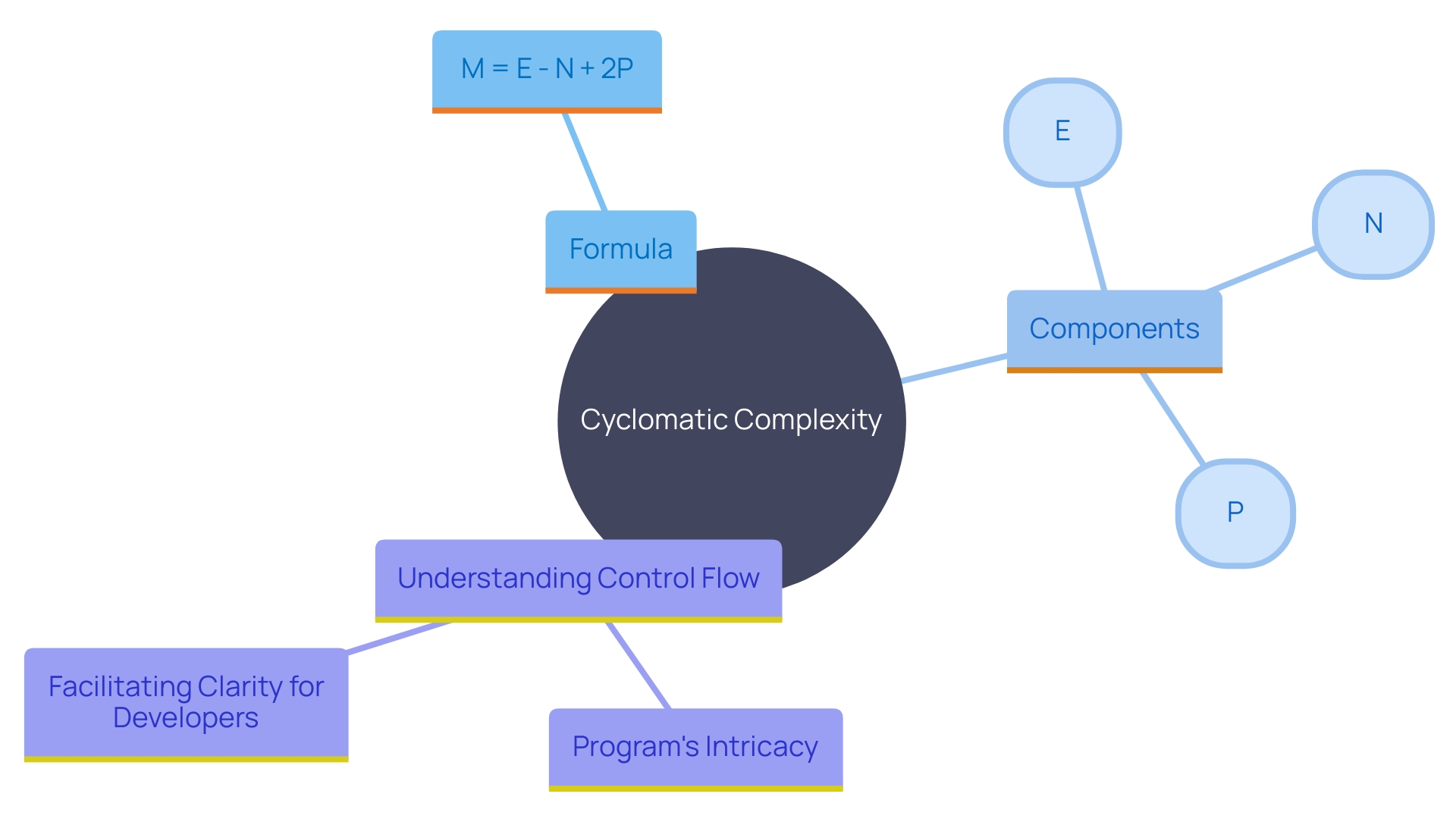
The Importance of Cyclomatic Complexity in Software Engineering
Cyclomatic intricacy is an essential measure in software engineering, playing a significant role in managing and maintaining programs. Elevated degrees of cyclomatic intricacy frequently suggest more elaborate and potentially troublesome programming, which can result in a greater chance of defects and issues. By systematically assessing this intricacy, developers can identify difficult areas in the software repository, prioritize testing efforts, and refactor the scripts to improve their clarity and maintainability. A practical illustration of this is the Dep Tree tool, which visualizes program intricacy through a 3D force-directed graph, assisting developers in identifying and managing intricate segments effectively.
Furthermore, studies indicate that the relationship between programming quality and defect counts is significant. Elevated cyclomatic intricacy frequently associates with programming that demands specialized knowledge and abilities to comprehend and sustain, as evident with advanced functional programming techniques. This specialized programming, classified at levels 3-4 on the difficulty scale, requires a higher cognitive load and can be understood by only a select few developers. 'Maintaining a balance, where most of the programming remains at level 2 with minimal portions at higher difficulty levels, is essential for ensuring the codebase remains accessible and manageable.'.
High-resolution data sets from over 50 proprietary codebases reveal a non-linear relationship between program health and business impact, emphasizing the importance of maintaining low structural intricacy to maximize system robustness and reliability. By comprehending and controlling the intricacies of software structure, development teams can create more resilient and dependable software, ultimately resulting in substantial returns on investment and improved overall software quality.
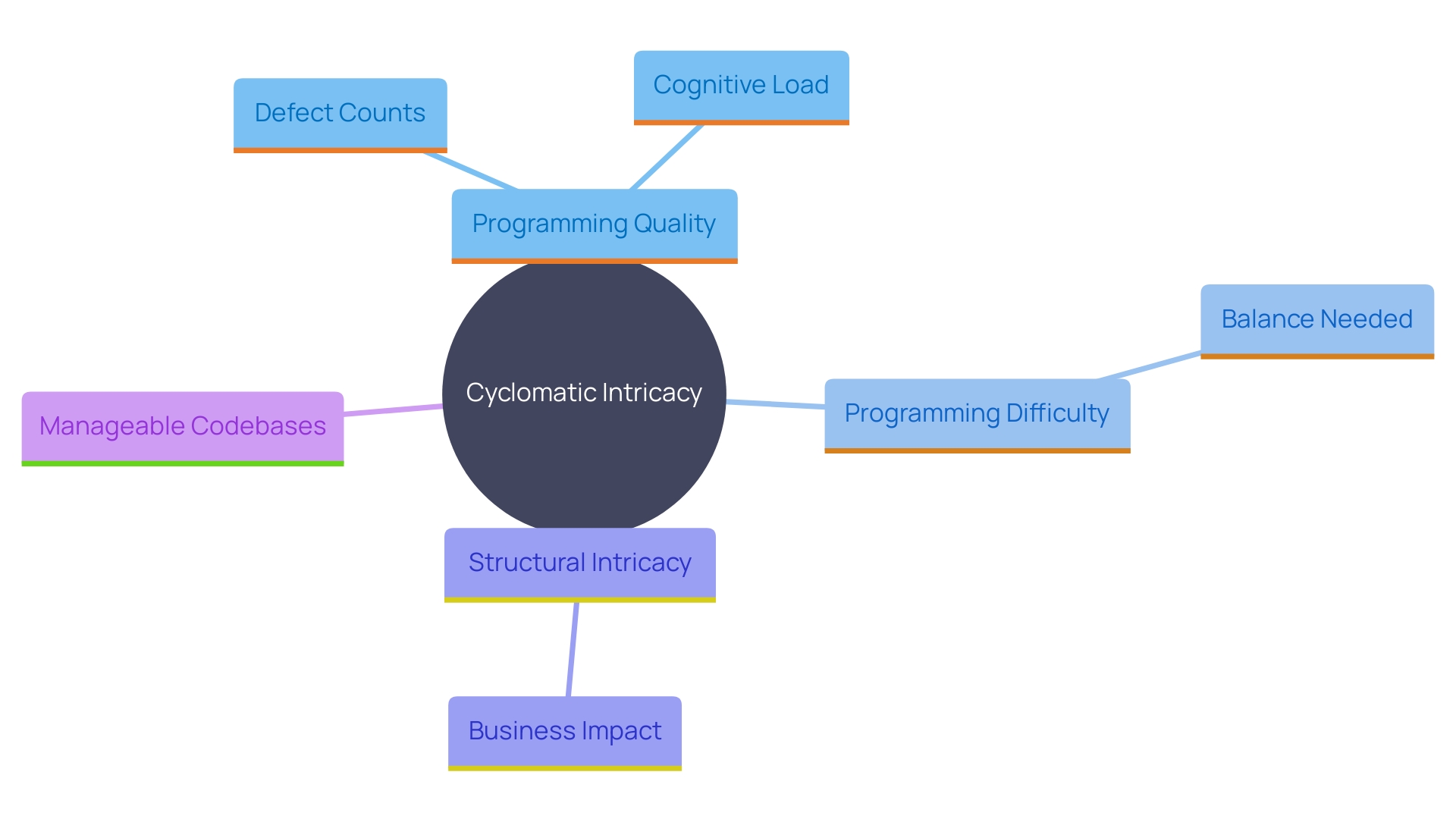
Cyclomatic Complexity and Code Quality
Cyclomatic intricacy is an essential measure for evaluating software quality. Reduced cyclomatic complexity frequently suggests clearer, more understandable programming, whereas elevated values might denote complex logic that is more difficult to traverse. Consistently tracking this metric guarantees that teams follow programming standards and best practices, ultimately improving readability and maintainability.
A study involving over 50 proprietary software repositories revealed that the quality of the programming, measured on a scale from 1.0 to 10.0, correlates with business value. Even software rated as 'green' (healthy) hasn't fully optimized its potential, highlighting the importance of continuous evaluation. By categorizing software as Green, Yellow, or Red based on complexity and other design properties, organizations can communicate quality metrics more effectively, even to non-technical stakeholders.
Empirical evidence shows that developers' behavior adapts based on the quality of the code they encounter, emphasizing the impact of maintaining high code standards for future development. Integrating these practices can significantly boost productivity, reduce defects, and lower maintenance costs, ensuring that software development remains both efficient and high-quality.
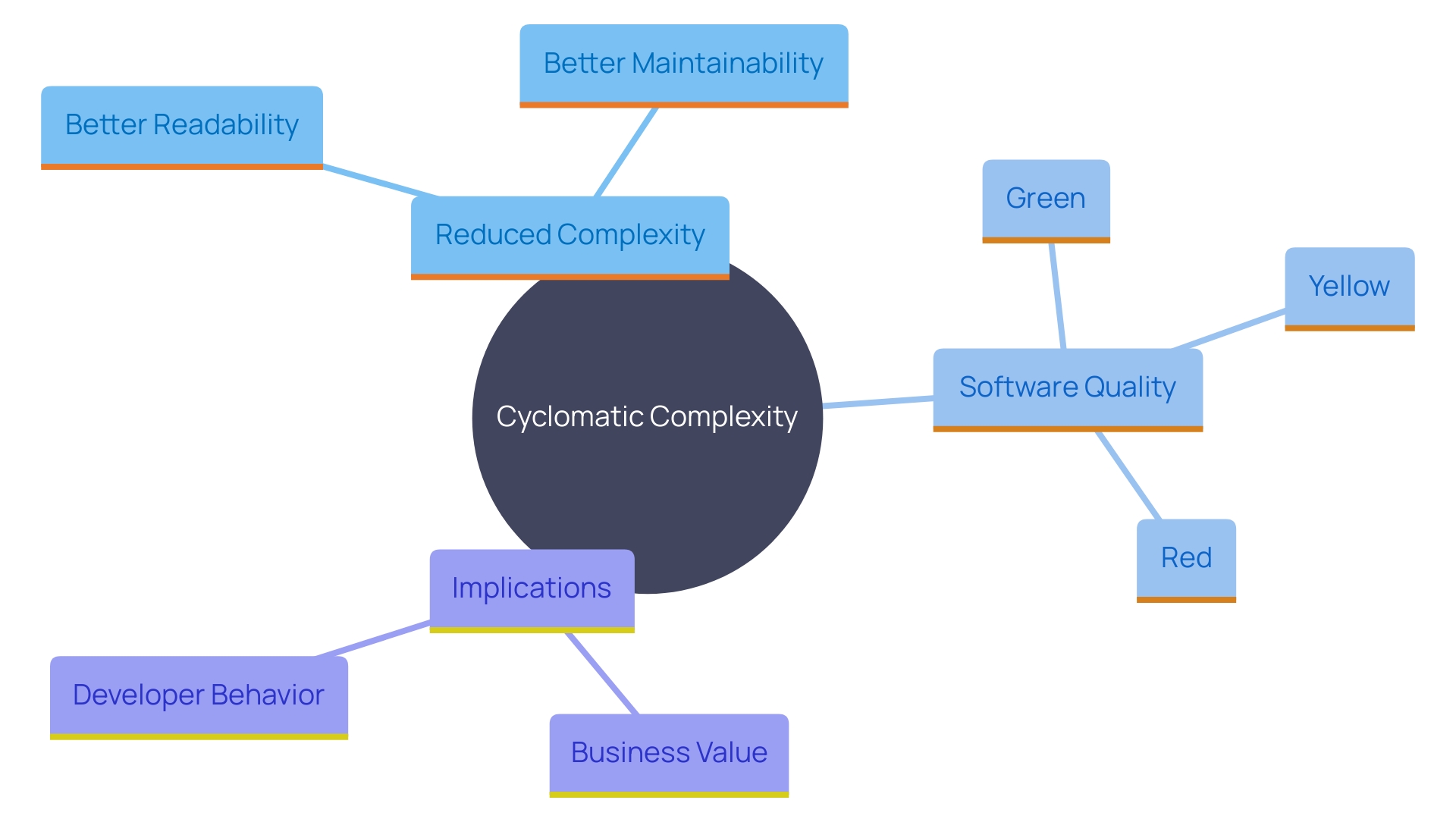
Cyclomatic Complexity and Testing
Cyclomatic intricacy plays a crucial role in the testing process, as it directly impacts the number of test cases needed to comprehensively cover all possible execution paths. Increased cyclomatic intricacy suggests the necessity for additional test cases, guaranteeing comprehensive validation. This metric enables testers to strategically prioritize their efforts, concentrating on the most intricate and error-prone sections, thereby enhancing testing efficiency. For example, research has demonstrated that optimizing regression test selection based on code intricacy can greatly decrease testing time without sacrificing the ability to identify bugs. By leveraging advanced methodologies, such as Large Language Models (LLMs), testers can further automate and refine test case generation, leading to more dependable results. As highlighted in recent research, integrating LLMs into the testing workflow not only improves test case accuracy but also addresses challenges related to model interpretability. This focused method, supported by factual data, highlights the significance of control flow analysis in providing high-quality software.
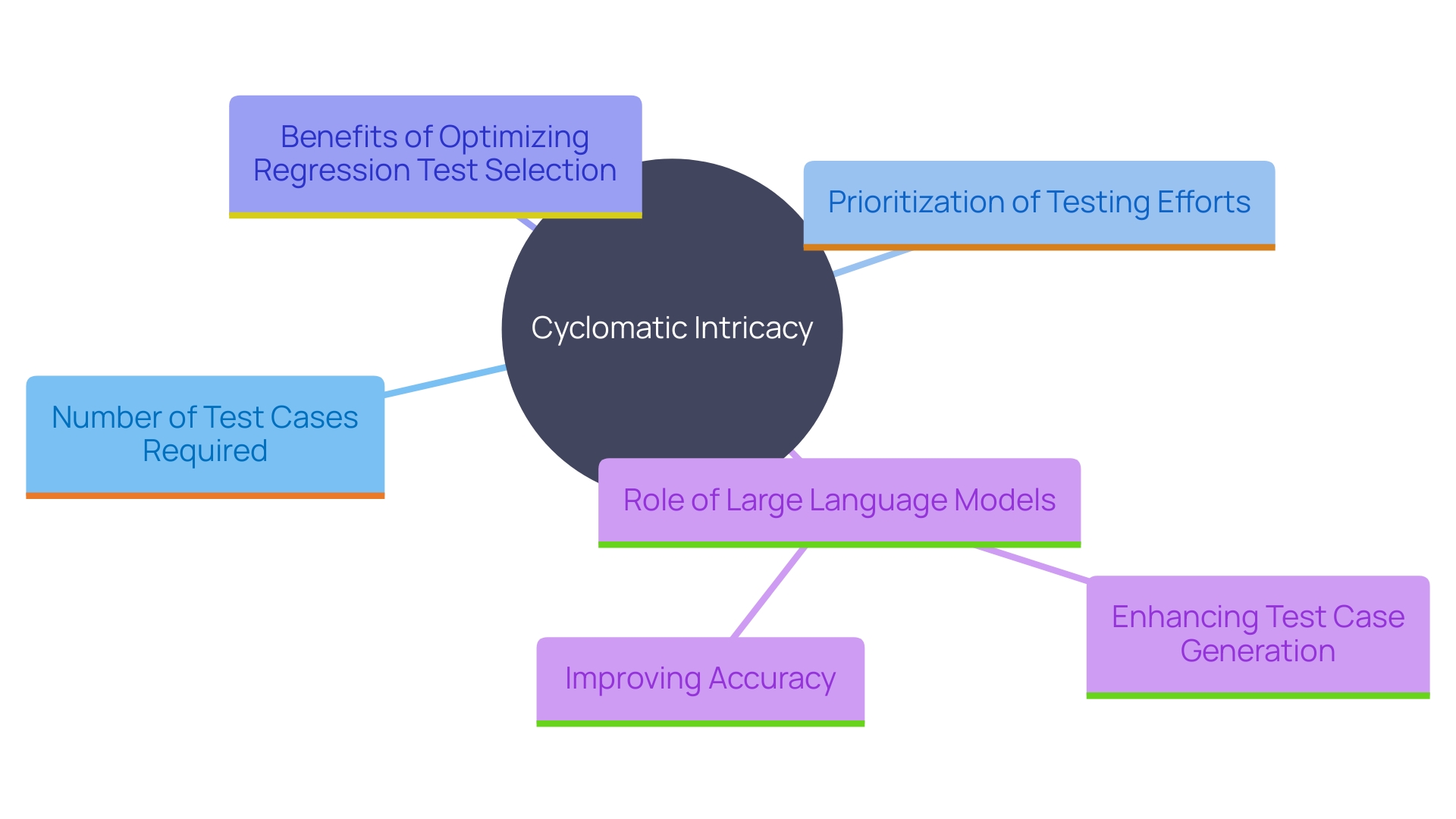
Strategies for Reducing Cyclomatic Complexity
To effectively minimize cyclomatic complexity, developers can utilize a range of strategies. Simplifying conditional statements is a fundamental approach. By reducing the number of branches within a function, the program becomes more straightforward and easier to manage. Another essential technique is breaking down large functions into smaller, more manageable ones. This not only enhances readability but also aligns with the Single Responsibility Principle (SRP), ensuring each function maintains a single level of abstraction. As one expert notes, “Each function should do One Thing, maintain a Single Level of Abstraction, and Minimize both code volume and the number of arguments passed.”
Employing polymorphism can also significantly reduce branching, making the code more flexible and easier to extend. Implementing design patterns that encourage reuse and modularity, such as the Strategy or Factory patterns, can further simplify intricacies. This modular approach ensures the codebase remains open for extension but closed for modification, adhering to SOLID principles and minimizing the risk of regression or bugs.
Frequent reviews and refactoring sessions are essential in keeping low cyclomatic complexity. 'These practices help identify and eliminate issues, such as duplicated segments and lengthy, intricate methods, which can impede efficiency and increase technical debt.'. As emphasized in a case analysis from Google, ML-suggested modifications have been demonstrated to considerably enhance productivity by enabling developers to concentrate on more innovative and intricate tasks.
Integrating these strategies not only lowers structural intricacy but also improves the overall quality and maintainability of the codebase, ensuring it stays strong and flexible for future modifications.
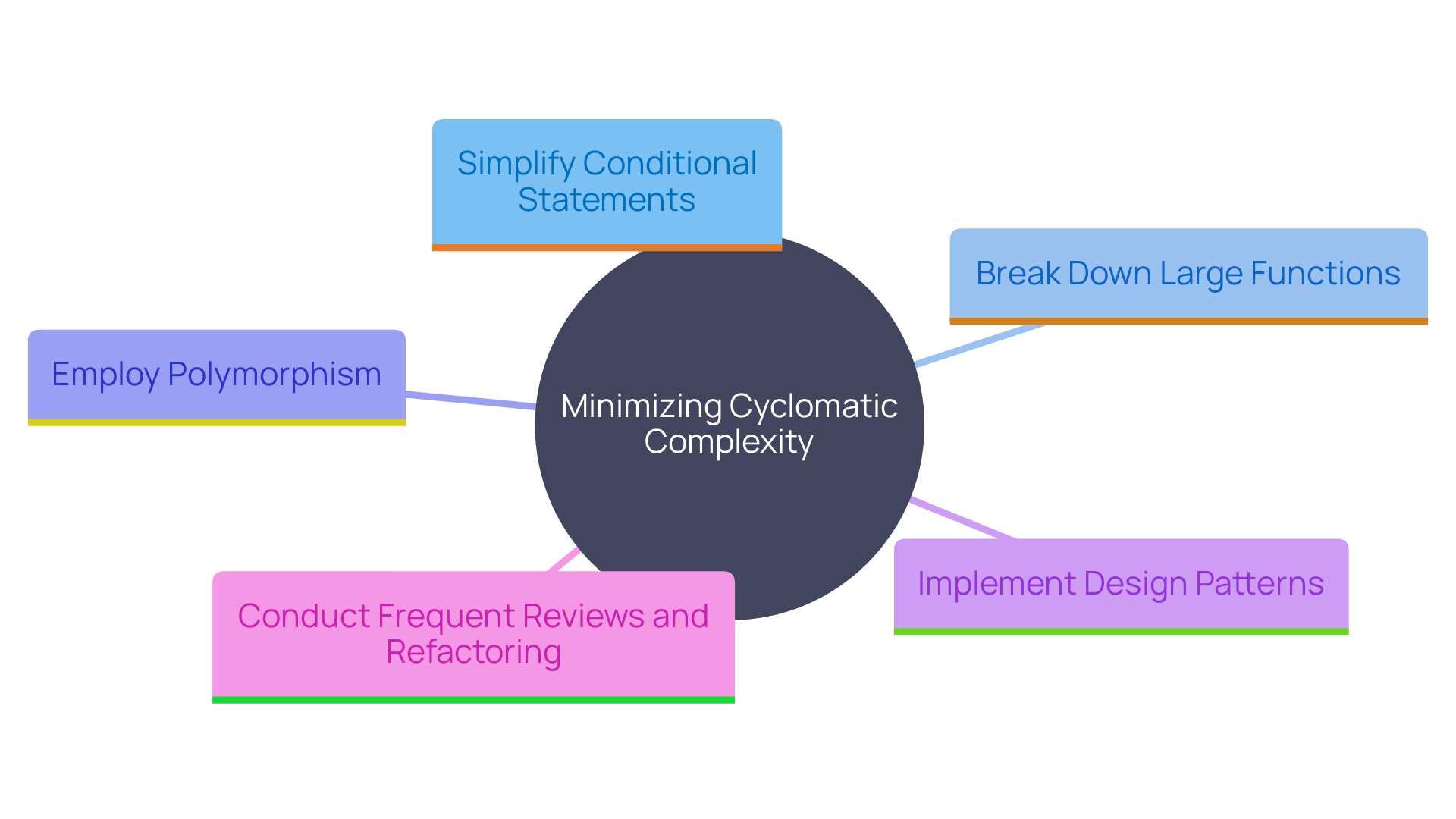
Tools for Measuring Cyclomatic Complexity
Evaluating software intricacy has become easier with different tools that offer automated evaluations of programming. Notable static analysis tools such as SonarQube, CodeClimate, and ESLint feature cyclomatic intricacy metrics in their reports. These tools assist developers in pinpointing the number of decision points in their programming, providing a numerical assessment of its intricacy. Incorporating such tools into the development pipeline guarantees ongoing observation and enhancement, keeping intricacy at manageable levels. By doing so, teams can monitor intricacy patterns over time, which is essential for preserving software quality and minimizing the chance of mistakes. As noted in a study by Patrizia Schalk and colleagues, understanding and managing complexity is vital for creating processes that are not only functional but also easy to understand and maintain. Advanced software delivery practices have emerged to meet the increasing demands for speed, quality, and efficiency, reinforcing the importance of tools that aid in source code analysis and manipulation.
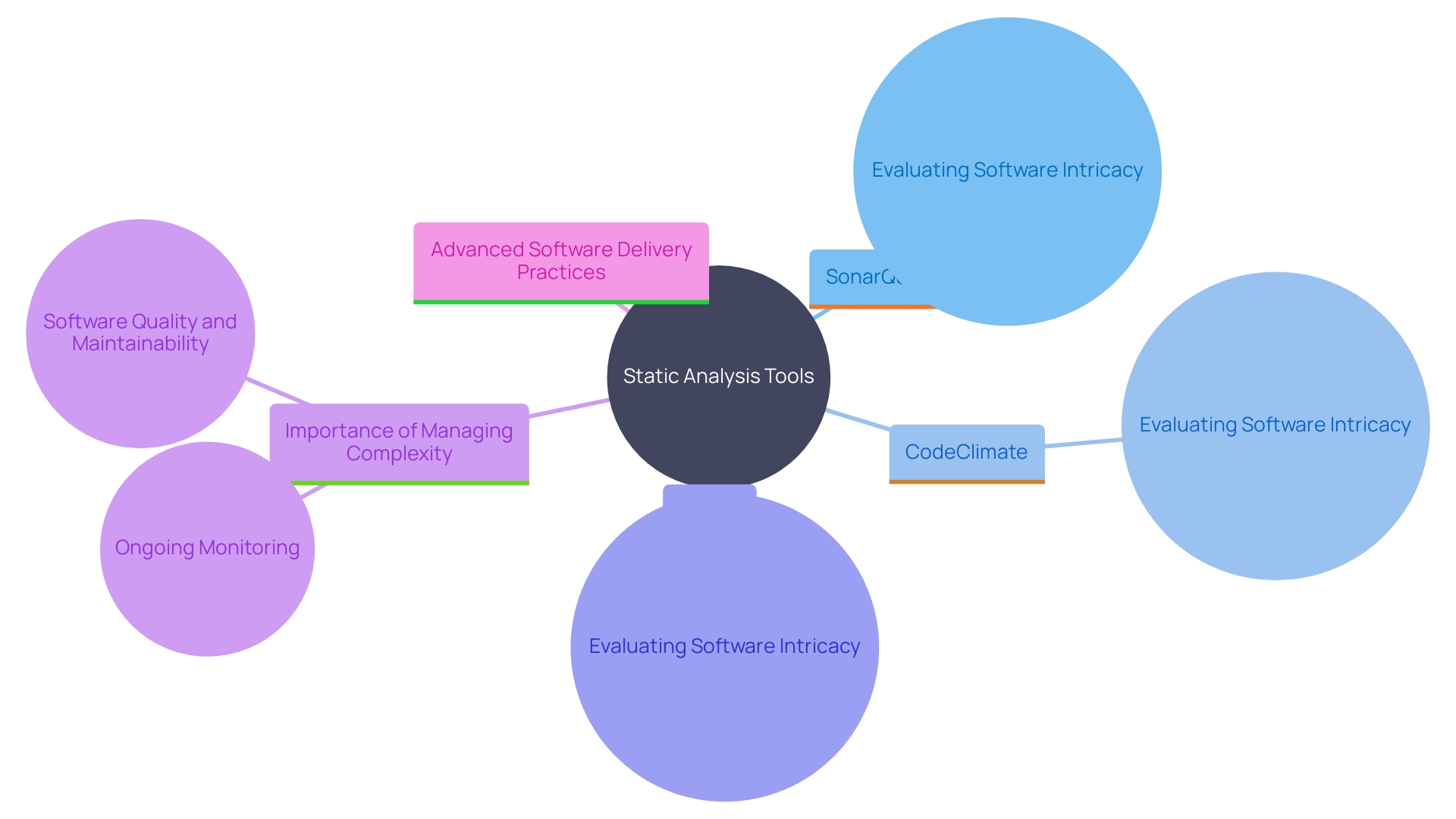
Conclusion
Maintaining optimal levels of cyclomatic complexity is essential for producing high-quality software. This metric serves as a valuable guide for developers, highlighting areas that may require simplification or refactoring. Utilizing tools like Phanalist and Dep Tree enables teams to visualize and quantify complexity, ensuring that code remains manageable and easier to maintain.
By keeping cyclomatic complexity below recommended thresholds, developers can significantly reduce the risk of defects and enhance overall code quality.
The historical significance of cyclomatic complexity cannot be understated. Introduced by Thomas J. McCabe in 1976, this metric has evolved to become a standard in software engineering practices. Its integration into modern development tools reflects a growing recognition of the importance of code quality and maintainability.
As software systems become increasingly complex, the need for effective measurement and management strategies becomes paramount.
Strategies for reducing cyclomatic complexity, such as simplifying conditional statements and breaking down large functions, can lead to more readable and maintainable code. Regular code reviews and the adoption of design patterns further enhance code quality, making it easier to adapt to future changes. By embracing these practices, software teams can ensure that they deliver robust and reliable solutions, maximizing both efficiency and productivity.
In conclusion, prioritizing cyclomatic complexity is not just about adhering to coding standards; it is a strategic approach that directly impacts the success of software development projects. By fostering a culture of continuous evaluation and improvement, organizations can achieve significant returns on investment, ultimately leading to better software outcomes and enhanced business value.
Frequently Asked Questions
What is cyclomatic complexity?
Cyclomatic complexity is a software metric used to evaluate the intricacy of a program's control flow. It calculates the number of linearly independent paths through a program's code, providing insights into the difficulties in understanding, maintaining, or testing different sections.
Why is cyclomatic complexity important?
It is crucial for developers focused on software quality and efficiency as it highlights complex areas that may need refactoring. Keeping cyclomatic complexity low helps ensure code remains manageable and easier to maintain.
How is cyclomatic complexity calculated?
Cyclomatic complexity (M) is calculated using the formula: M = E - N + 2P, where E is the number of edges in the control flow graph, N is the number of nodes in the graph, and P is the number of connected components (usually 1 for a single program).
What tools can help compute cyclomatic complexity?
Tools like Phanalist and Dep Tree assist in visualizing and calculating code intricacy. Phanalist computes structural intricacy and encourages refactoring methods that exceed a complexity level of 10, while Dep Tree uses a 3D graph to illustrate connections among source files.
How does cyclomatic complexity relate to software quality?
Higher cyclomatic complexity often indicates elaborate programming, which can lead to a greater chance of defects. By assessing complexity, developers can prioritize testing efforts and refactor code to improve clarity and maintainability.
What are the implications of high cyclomatic complexity?
Elevated cyclomatic complexity suggests that the code may require specialized knowledge to understand and maintain, leading to increased risk of defects and higher maintenance costs.
How can developers reduce cyclomatic complexity?
Developers can simplify conditional statements, break down large functions into smaller ones, and use design patterns that promote modularity. Regular code reviews and refactoring sessions are also essential to keep cyclomatic complexity low.
What role does cyclomatic complexity play in the testing process?
Cyclomatic complexity directly impacts the number of test cases required to cover all possible execution paths. Higher complexity necessitates additional test cases, allowing testers to focus on the most intricate and error-prone sections of the code.
How can automated tools assist in managing cyclomatic complexity?
Static analysis tools like SonarQube, CodeClimate, and ESLint offer cyclomatic complexity metrics in their reports. These tools help developers identify decision points in their code, ensuring ongoing monitoring and maintenance of code quality.
What is the impact of managing cyclomatic complexity on business value?
Maintaining low cyclomatic complexity is linked to improved software quality and reduced maintenance costs, ultimately leading to a better return on investment and enhanced reliability of software systems.




